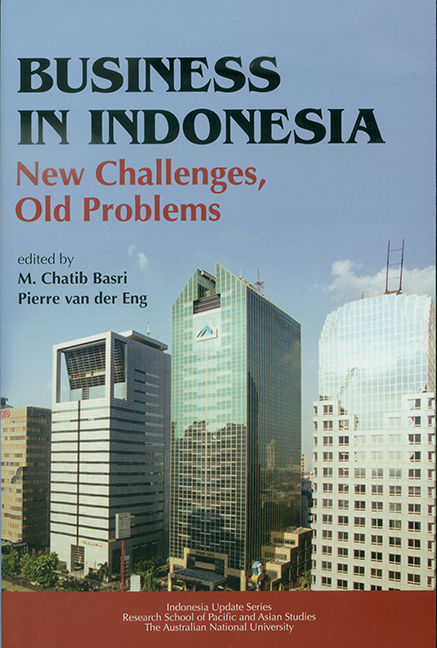Book contents
- Frontmatter
- Contents
- Tables
- Figures
- Contributors
- Acknowledgments
- Glossary
- 1 Business in Indonesia: Old Problems and New Challenges
- PART I Political and Economic Developments
- PART II Overview of the Business Environment
- PART III Foreign Investment and Trade
- PART IV Key Issues in the Business Environment
- 8 The Effects of Decentralisation on Business in Indonesia
- 9 Political Economy of Privatisation of State-owned Enterprises in Indonesia
- 10 Corporate Ownership and Management in Indonesia: Does It Change?
- 11 Tinkering Around the Edges: Inadequacy of Corporate Governance Reform in Post-Crisis Indonesia
- 12 Upholding Indonesian Bankruptcy Legislation
- 13 The Private Sector Response to Public Sector Corruption
- 14 A Challenge for Business? Developments in Indonesian Trade Unionism after Soeharto
- 15 Labour Regulation and the Business Environment: Time to Take Stock
- References
- Index
- Indonesia Update Series
12 - Upholding Indonesian Bankruptcy Legislation
from PART IV - Key Issues in the Business Environment
Published online by Cambridge University Press: 21 October 2015
- Frontmatter
- Contents
- Tables
- Figures
- Contributors
- Acknowledgments
- Glossary
- 1 Business in Indonesia: Old Problems and New Challenges
- PART I Political and Economic Developments
- PART II Overview of the Business Environment
- PART III Foreign Investment and Trade
- PART IV Key Issues in the Business Environment
- 8 The Effects of Decentralisation on Business in Indonesia
- 9 Political Economy of Privatisation of State-owned Enterprises in Indonesia
- 10 Corporate Ownership and Management in Indonesia: Does It Change?
- 11 Tinkering Around the Edges: Inadequacy of Corporate Governance Reform in Post-Crisis Indonesia
- 12 Upholding Indonesian Bankruptcy Legislation
- 13 The Private Sector Response to Public Sector Corruption
- 14 A Challenge for Business? Developments in Indonesian Trade Unionism after Soeharto
- 15 Labour Regulation and the Business Environment: Time to Take Stock
- References
- Index
- Indonesia Update Series
Summary
When the Asian economic crisis hit Indonesia in 1997, the Indonesian government initiated commercial sector reform. The need for institutional reform in this sector was widely recognised in Indonesia before the crisis. All Indonesian legal professions, both public and private, had in fact agreed on a course of reform, reflected in the 1997 ‘Legal Diagnostic’. The Legal Diagnostic recognised the difficulties posed by wholesale reform and identified commercial law as one of the key areas in which to proceed. In 1998, the International Monetary Fund (IMF) began to plan an incentive scheme for private debt restructuring and credible enforcement through a new bankruptcy court, the Commercial Court. They used some of the Legal Diagnostic recommendations in this task. By the end of March 1998, the IMF and the Indonesian government had agreed on how to proceed with bankruptcy law reform and had outlined a set of principles to be followed. Throughout March and April, a team appointed by the Indonesian government drafted the amendments to the bankruptcy law.
In June 1998, the government established a steering committee to oversee preparations for the operation of the Commercial Court. The committee consisted of representatives from the Supreme Court, the State Secretariat, the Department of Justice and the National Development Planning Agency (Bappenas); it paid close attention to the selection of competent and reliable judges, the establishment of the Commercial Court, the proper education of the judges appointed to the Commercial Court, and the appointment and education of private independent receivers and administrators. On 20 August 1998, the amendments to the Indonesian Bankruptcy Law became effective and the Commercial Court was opened. The bankruptcy law amendments significantly revised the Indonesian Bankruptcy Ordinance of 1906, as we will discuss further below.
The objective of the bankruptcy law reform was to provide a system that would guarantee speedy, efficient and transparent restructuring and bankruptcy proceedings. The amendments ocused on maximising asset recovery, equitability and predictability, and on providing opportunities for reorganisations.
These bankruptcy law amendments were enacted more than five years ago. In magazines, newspapers and legal studies, there has been much discussion on whether the objectives have been reached and, if so, to what extent. The articles make three main points. First, the system is vulnerable to corruption.
- Type
- Chapter
- Information
- Business in IndonesiaNew Challenges, Old Problems, pp. 191 - 203Publisher: ISEAS–Yusof Ishak InstitutePrint publication year: 2004



